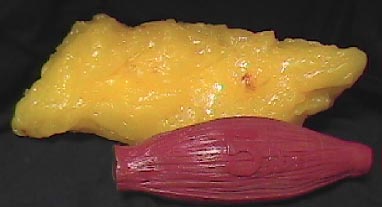The only tissue in the body that burns fat is muscle. Your resting metabolic rate, which accounts for more than half the calories you burn in a single day is mostly governed by how much muscle you have. So, lets say that 60% of your caloric expenditure comes from your resting metabolic rate, 25% comes from some sort of activity be it weight training or cardiovascular exercise, and 15% comes the Thermic Effect of Food (food has a thermic effect, which means it burns calories as you consume them. Protein has a high thermic effect, simple sugars like candy do not). If you do not weight train and increase your lean muscle mass; thereby, increasing your resting metabolic rate (which has the highest percentage of your metabolism), then you are completely missing the boat in regards to your fat loss!

What do you want your body weight to consist of?

What do you want your body weight to consist of?
Beginners to weight lifting will actually experience gains in muscle mass while burning fat. At some point, that will stop and the only way to gain muscle mass is to consume more calories than you expend. Muscle cannot be developed through a caloric deficit - so women on a diet who are afraid of becoming bulky are incredibly off base. Women, physiologically, don't have the same muscle building properties as men.
I could go on and on regarding my thoughts on different myths in the female fitness realm, but that would take quite a bit of time so I'll just go through a quick rundown of what we did in that 8-week period.
1) Foam Rolling and soft tissue work
2) Dynamic warm ups
3) Strength training protocols
4) Interval Training
5) Steady State Cardio Training
6) Static Stretching
7) Circuit Training
8) Sample total body workout
Definitely a lot to go over in just 8 sessions, but I definitely think I dispelled some myths and the participants learned quite a bit on how to program their own workouts. Here's a couple of videos we took:
Reverse Lunge From Deficit:
The step forces the glutes to work a little harder because of the extra range of motion while also causing a deeper stretch to the often tight hip flexors in the back leg.
X Pulldown - X Pulldowns combine scapular retraction as well as depression. Combine that with the "shoulder friendly" rotation of the handles and the cross body motion of the exercise and you get a much more effective movement over the standard lat pulldown machine.
Tall Kneeling Sequential Lift: Core stability while working the body in three planes of motion (diagonally).
Towel Hamstring Curls: Glute/Hamstring strength...also keeps your floors clean!
Face Pulls: An extremely underrated exercise that targets the upper back musculature as well as the rear delts and rotator cuff. It's crucial for shoulder health and also helps reinforce better posture.
Unfortunately, Joanna was away when I took these video clips but she she did an awesome job as well in the other weeks! All in all, I think everyone had a great time getting stronger, fixing any imbalances and also just being in better shape! Big thanks to Kate and Anne for allowing me to film some of the stuff we did in class!
Great job, girls!
Jason





